Energetic, Exergetic, and Heat Transfer Assessment of PCM-Integrated Heat-Pipe-Based ETSC for Clear and Cloudy Weather Conditions
Abstract
:1. Introduction
2. Experimental Setup and Methodology
2.1. Selection of PCM (Phase-I)
2.2. Experimental Setup Description
2.3. Experimental Methodology
3. Heat Transfer and Thermal Performance Analysis
3.1. Heat Transfer/Thermal Losses Assessment
3.2. Thermal Resistance for PCM Filled Heat Pipe Based ETSC
3.3. Energy Assessment
3.4. Exergetic Assessment
3.5. Uncertainty Study
4. Results and Discussions
4.1. Heat Transfer Assessment for Developed Collector
4.2. Variation of Solar Energy and Ambient Temperature for Clear and Cloudy Days
4.3. Variation of Thermal Energy Gain for a Clear and Cloudy Test Days
4.4. Variation of Average PCM Temperature with Time for Clear and Cloudy Test Days
4.5. Variation in Outlet/Inlet Water Temperature for Both Clear and Cloudy Test Days
4.6. Daily Energetic and Exergetic Efficiencies of HP-Based ETC–SWH
5. Conclusions
- The proposed collector obtained a better thermal output than conventional systems (validated by other studies). This happened because of the storage of excess heat energy in the PCM during the daytime, which was utilized in late-night hours.
- The calculated overall heat transfer coefficients (UL) found via COMSOL Multiphysics for clear and cloudy days were 0.75 and 0.72 W/m2 K, respectively. This shows that losses were at a minimum for cloudy weather conditions.
- The daily useful amounts of energy collected by water were 10.65 MJ and 8.52 MJ for clear and cloudy test days. The maximum water outlet temperatures were 62.2 °C and 50.4 °C, and the storage tank temperatures were 45 °C and 41 °C, respectively, for clear and cloudy day conditions.
- The daily average energetic and exergetic outputs of the developed collector for the clear test day were found to be 76.57% and 2.37%, whereas the corresponding values for the cloudy test day were 79.64%, and 1.38%, respectively.
- The daily thermal output of the developed collector was higher for a cloudy test day compared to a clear day, which means that the developed system can be considered as a feasible option for on-demand hot water production during partially overcast weather conditions.
Author Contributions
Funding
Informed Consent Statement
Data Availability Statement
Conflicts of Interest
Nomenclature
| Cp,w | Water-specific heat (J/kg K) |
| Exgain | Exergy gain (J) |
| Exout | Exergy at the outlet (J) |
| Exin | Exergy at the inlet (J) |
| Exsolar | Incident solar exergy (J) |
| Quseful | Useful amount of energy (W) |
| Qabsorbed | Energy absorbed by collector (W) |
| mw | Mass flow rate of water (LPH) |
| IT | Solar radiation (W/m2) |
| Aaperture | Aperture area (m2) |
| σ | Stefan–Boltzmann constant (W/m2 K4) |
| Ai | Inner surface area of tube (m2) |
| Ao | Outer surface area of tube (m2) |
| εt,i | Emissivity of inner surface |
| εt,o | Emissivity of outer surface |
| Le and Lc | Length of evaporator and condenser (m) |
| khp | Thermal conductivity of copper (W/m K) |
| de and dc | Diameter of evaporator and condenser (m) |
| Tt,o | Temperature of outer surface (°C) |
| Tt,i | Temperature of outer surface (°C) |
| ηDTE | Daily thermal efficiency |
| ηDEX | Daily exergy efficiency |
| Abbreviations | |
| DSC | Differential scanning calorimetry |
| ET | Evacuated tube |
| ETSC | Evacuated tube solar collector |
| LHS | Latent heat storage |
| TES | Thermal energy storage |
| PCM | Phase change material |
| LPH | Liter per hour |
| SWH | Solar water heater |
| MJ | Mega joule |
| HP | Heat pipe |
References
- Gao, Y.; Fan, R.; Zhang, X.; An, Y.; Wang, M.; Yu, Y. Thermal performance and parameter analysis of a U-pipe evacuated solar tube collector. Sol. Energy 2014, 107, 714–727. [Google Scholar] [CrossRef]
- Goel, V.; Hans, V.; Singh, S.; Kumar, R.; Pathak, S.K.; Singla, M.; Bhattacharyya, S.; Almatrafi, E.; Gill, R.; Saini, R. A comprehensive study on the progressive development and applications of solar air heaters. Sol. Energy 2021, 229, 112–147. [Google Scholar] [CrossRef]
- Ahmed, S.F.; Khalid, M.; Vaka, M.; Walvekar, R.; Numan, A.; Rasheed, A.K.; Mubarak, N.M. Recent progress in solar water heaters and solar collectors: A comprehensive review. Therm. Sci. Eng. Progress 2021, 25, 100981. [Google Scholar] [CrossRef]
- Naik, B.K.; Premnath, S.; Muthukumar, P. Performance comparison of evacuated U-tube solar collector integrated parabolic reflector with conventional evacuated U-tube solar collector. Sadhana—Acad. Proc. Eng. Sci. 2021, 46, 137. [Google Scholar] [CrossRef]
- Ahmed, M.A.; Rofaiel, I.Y.; Essa, M.A. Experimental study for the performance of an integrated solar collector water heater based on helical fins heat pipes using phase changing material. Egypt. J. Eng. Sci. Technol. 2020, 30, 22–38. [Google Scholar] [CrossRef]
- Li, C.; Zhang, B.; Xie, B.; Zhao, X.; Chen, J.; Chen, Z.; Long, Y. Stearic acid/expanded graphite as a composite phase change thermal energy storage material for tankless solar water heater. Sustain. Cities Soc. 2019, 44, 458–464. [Google Scholar] [CrossRef]
- Elbrashy, A.; Abou-Taleb, F.; El-Fakharany, M.K.; Essa, F.A. Experimental study of solar air heater performance by evacuated tubes connected in series and loaded with thermal storage material. J. Energy Storage 2022, 54, 105266. [Google Scholar] [CrossRef]
- Wu, W.; Wang, X.; Xia, M.; Dou, Y.; Yin, Z.; Wang, J.; Lu, P. A novel composite PCM for seasonal thermal energy storage of solar water heating system. Renew. Energy 2020, 161, 457–469. [Google Scholar] [CrossRef]
- Chopra, K.; Tyagi, V.V.; Pandey, A.K. Thermodynamic and techno-economic analysis of heat pipe ETC water heating system for Indian composite climate: An experimental approach. J. Therm. Anal. Calorim. 2020, 139, 1395–1407. [Google Scholar] [CrossRef]
- Abokersh, M.H.; El-Morsi, M.; Sharaf, O.; Abdelrahman, W. On-demand operation of a compact solar water heater based on U-pipe evacuated tube solar collector combined with phase change material. Sol. Energy 2017, 155, 1130–1147. [Google Scholar] [CrossRef]
- Shafieian, A.; Khiadani, M.; Nosrati, A. Thermal performance of an evacuated tube heat pipe solar water heating system in cold season. Appl. Therm. Eng. 2019, 149, 644–657. [Google Scholar] [CrossRef]
- Pawar, V.R.; Sobhansarbandi, S. Heat transfer enhancement of a PCM-porous metal-based heat pipe evacuated tube solar collector: An experimental study. Sol. Energy 2023, 251, 106–118. [Google Scholar] [CrossRef]
- Ben Khedher, N. Experimental Evaluation of a Flat Plate Solar Collector Under Hail City Climate. Eng. Technol. Appl. Sci. Res. 2018, 8, 2750–2754. [Google Scholar] [CrossRef]
- Alshukri, M.J.; Eidan, A.A.; Najim, S.I. Thermal performance of heat pipe evacuated tube solar collector integrated with different types of phase change materials at various location. Renew. Energy 2021, 171, 635–646. [Google Scholar] [CrossRef]
- Feliński, P.; Sekret, R. Effect of PCM application inside an evacuated tube collector on the thermal performance of a domestic hot water system. Energy Build. 2017, 152, 558–567. [Google Scholar] [CrossRef]
- Bazri, S.; Badruddin, I.A.; Naghavi, M.S.; Seng, O.K.; Wongwises, S. An analytical and comparative study of the charging and discharging processes in a latent heat thermal storage tank for solar water heater system. Sol. Energy 2019, 185, 424–438. [Google Scholar] [CrossRef]
- Hlaing, S.; Soe, M.M. Design Calculation and Heat Transfer Analysis of Heat Pipe Evacuated Tube Solar Collector for Water Heating. Int. J. Sci. Eng. Technol. Res. 2014, 3, 2606–2611. [Google Scholar]
- Wu, W.; Dai, S.; Liu, Z.; Dou, Y.; Hua, J.; Li, M.; Wang, X.; Wang, X. Experimental study on the performance of a novel solar water heating system with and without PCM. Sol. Energy 2018, 171, 604–612. [Google Scholar] [CrossRef]
- Chopra, K.; Tyagi, V.; Pandey, A.; Ma, Z.; Ren, H. Energy, exergy, enviroeconomic & exergoeconomic (4E) assessment of thermal energy storage assisted solar water heating system: Experimental & theoretical approach. J. Energy Storage 2021, 35, 102232. [Google Scholar] [CrossRef]
- Pathak, S.K.; Tyagi, V.; Chopra, K.; Kalidasan, B.; Pandey, A.; Goel, V.; Saxena, A.; Ma, Z. Energy, exergy, economic and environmental analyses of solar air heating systems with and without thermal energy storage for sustainable development: A systematic review. J. Energy Storage 2023, 59, 106521. [Google Scholar] [CrossRef]
- Eltaweel, M.; Abdel-Rehim, A.A. Energy and exergy analysis of a thermosiphon and forced-circulation flat-plate solar collector using MWCNT/Water nanofluid. Case Stud. Therm. Eng. 2019, 14, 100416. [Google Scholar] [CrossRef]
- Douvi, E.; Pagkalos, C.; Dogkas, G.; Koukou, M.K.; Stathopoulos, V.N.; Caouris, Y.; Vrachopoulos, M.G. Phase change materials in solar domestic hot water systems: A review. Int. J. Thermofluids 2021, 10, 100075. [Google Scholar] [CrossRef]
- Elarem, R.; Alqahtani, T.; Mellouli, S.; Aich, W.; Ben Khedher, N.; Kolsi, L.; Jemni, A. Numerical study of an Evacuated Tube Solar Collector incorporating a Nano-PCM as a latent heat storage system. Case Stud. Therm. Eng. 2021, 24, 100859. [Google Scholar] [CrossRef]
- Saxena, G.; Gaur, M.K. Energy, exergy and economic analysis of evacuated tube solar water heating system integrated with heat exchanger. Mater. Today Proc. 2020, 28, 2452–2462. [Google Scholar] [CrossRef]
- Ersöz, M.A. Effects of different working fl uid use on the energy and exergy performance for evacuated tube solar collector with thermosyphon heat pipe. Renew. Energy 2016, 96, 244–256. [Google Scholar] [CrossRef]
- Singh, I.; Vardhan, S. Energy, exergy, environmental and economic (4E) analysis of evacuated tube solar collector with helical coils. J. Mech. Sci. Technol. 2022, 36, 5801–5808. [Google Scholar] [CrossRef]
- Abo-Elfadl, S.; Yousef, M.S.; Hassan, H. Energy, exergy, and enviroeconomic assessment of double and single pass solar air heaters having a new design absorber. Process. Saf. Environ. Prot. 2021, 149, 451–464. [Google Scholar] [CrossRef]
- Essa, M.A.; Rofaiel, I.Y.; Ahmed, M.A. Experimental and Theoretical Analysis for the Performance of Evacuated Tube Collector Integrated with Helical Finned Heat Pipes using PCM Energy Storage. Energy 2020, 206, 118166. [Google Scholar] [CrossRef]

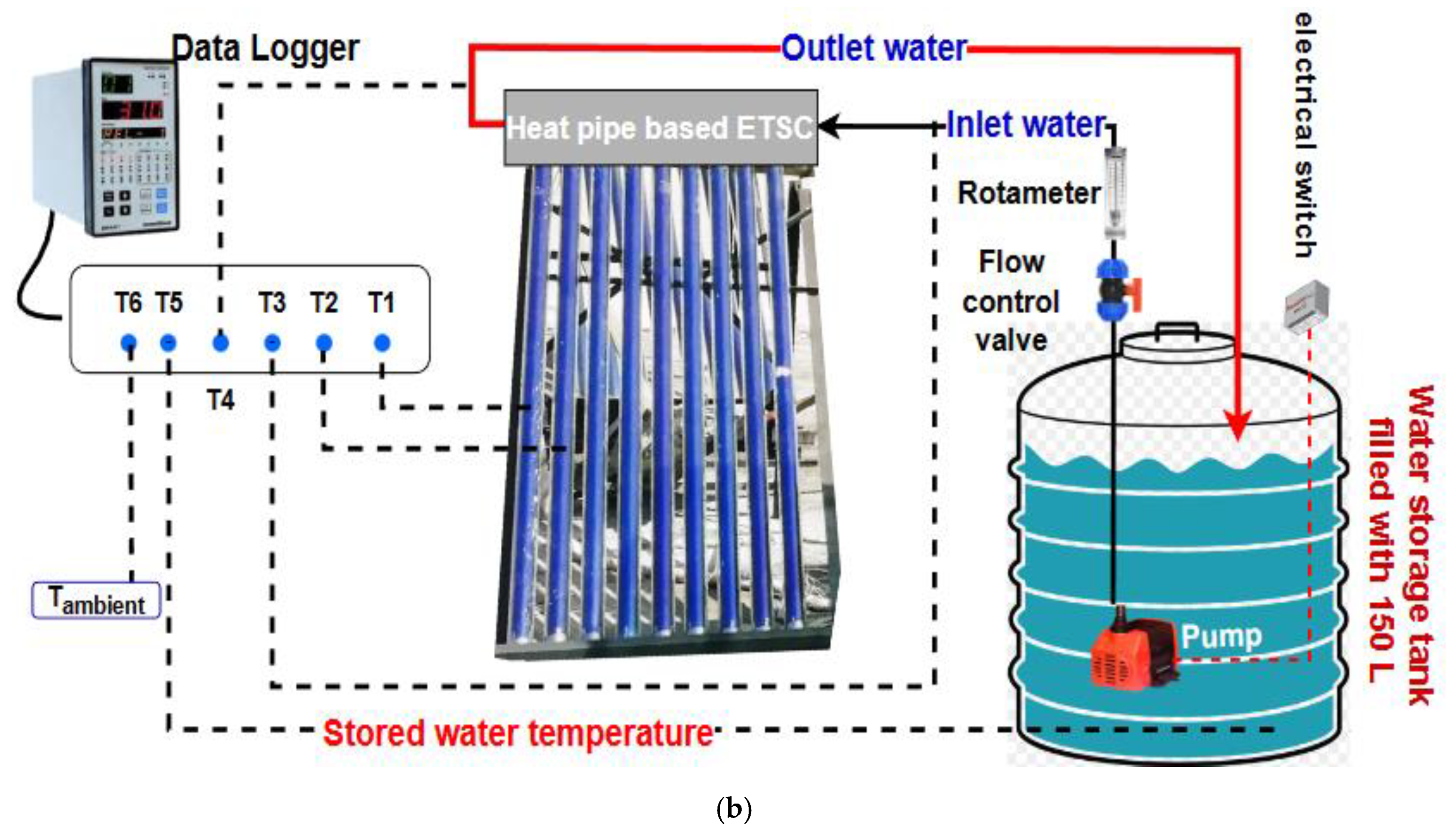
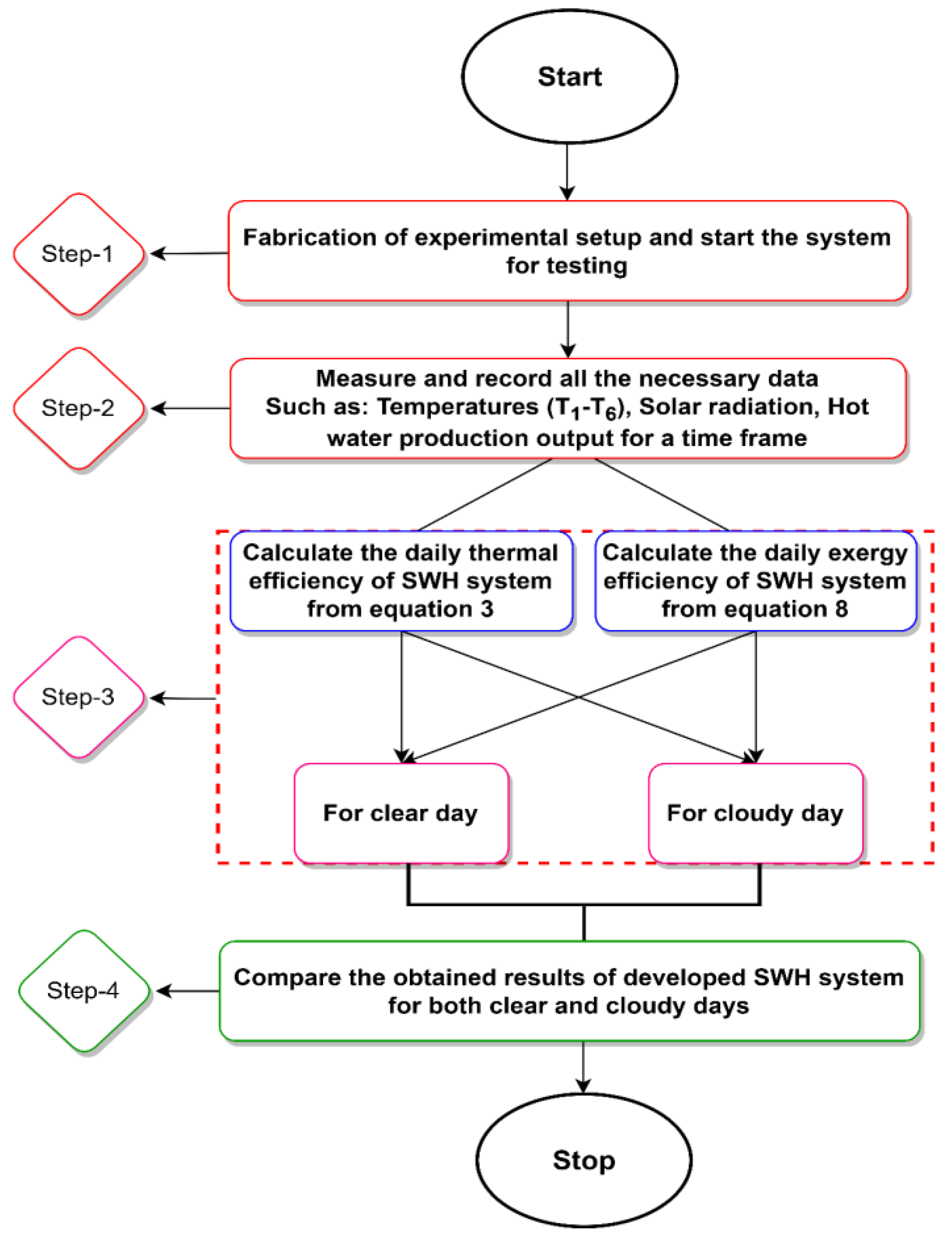


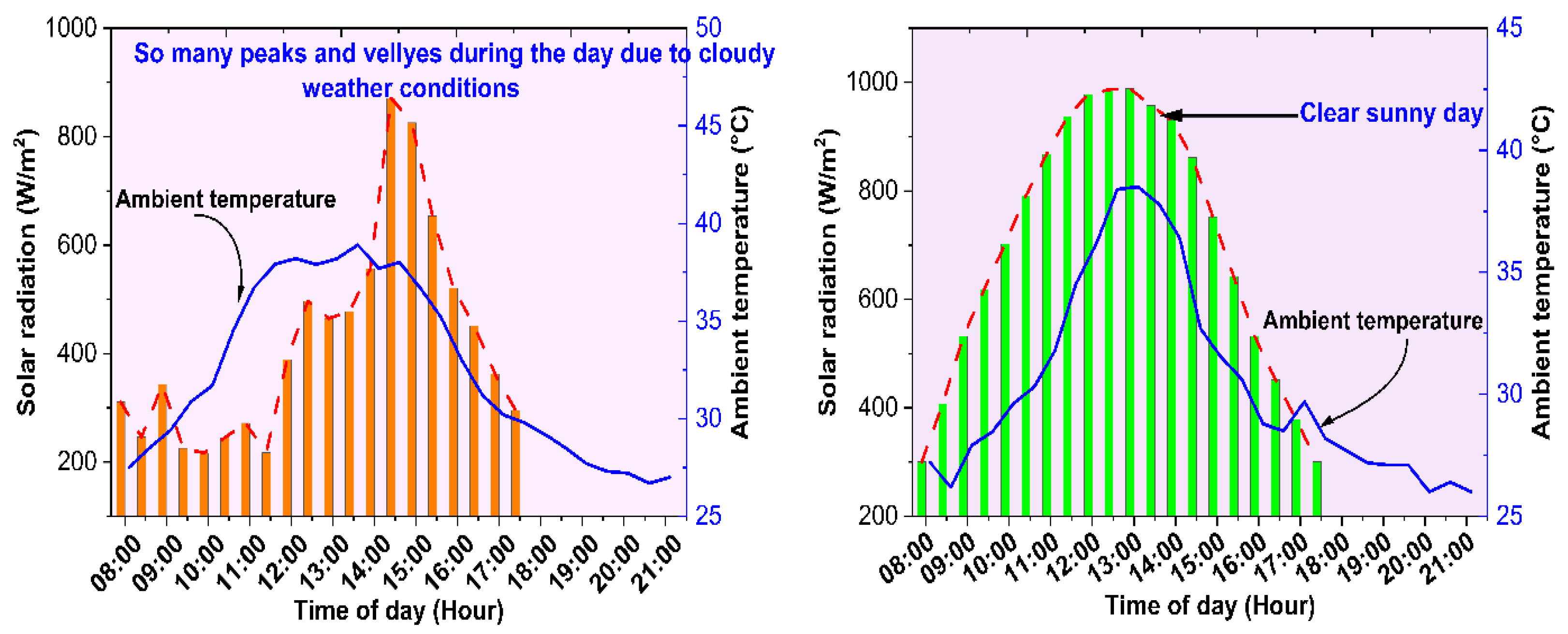
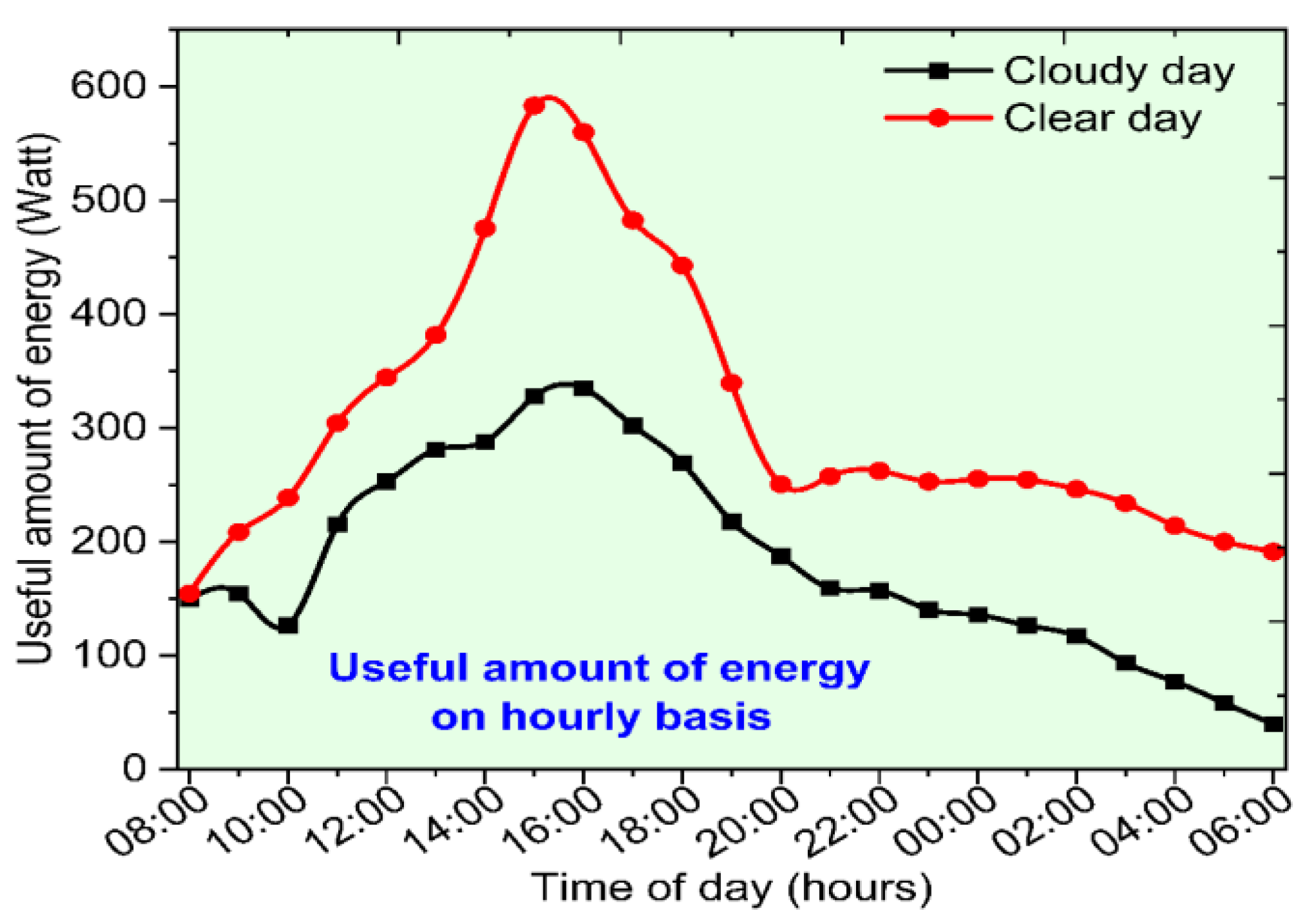
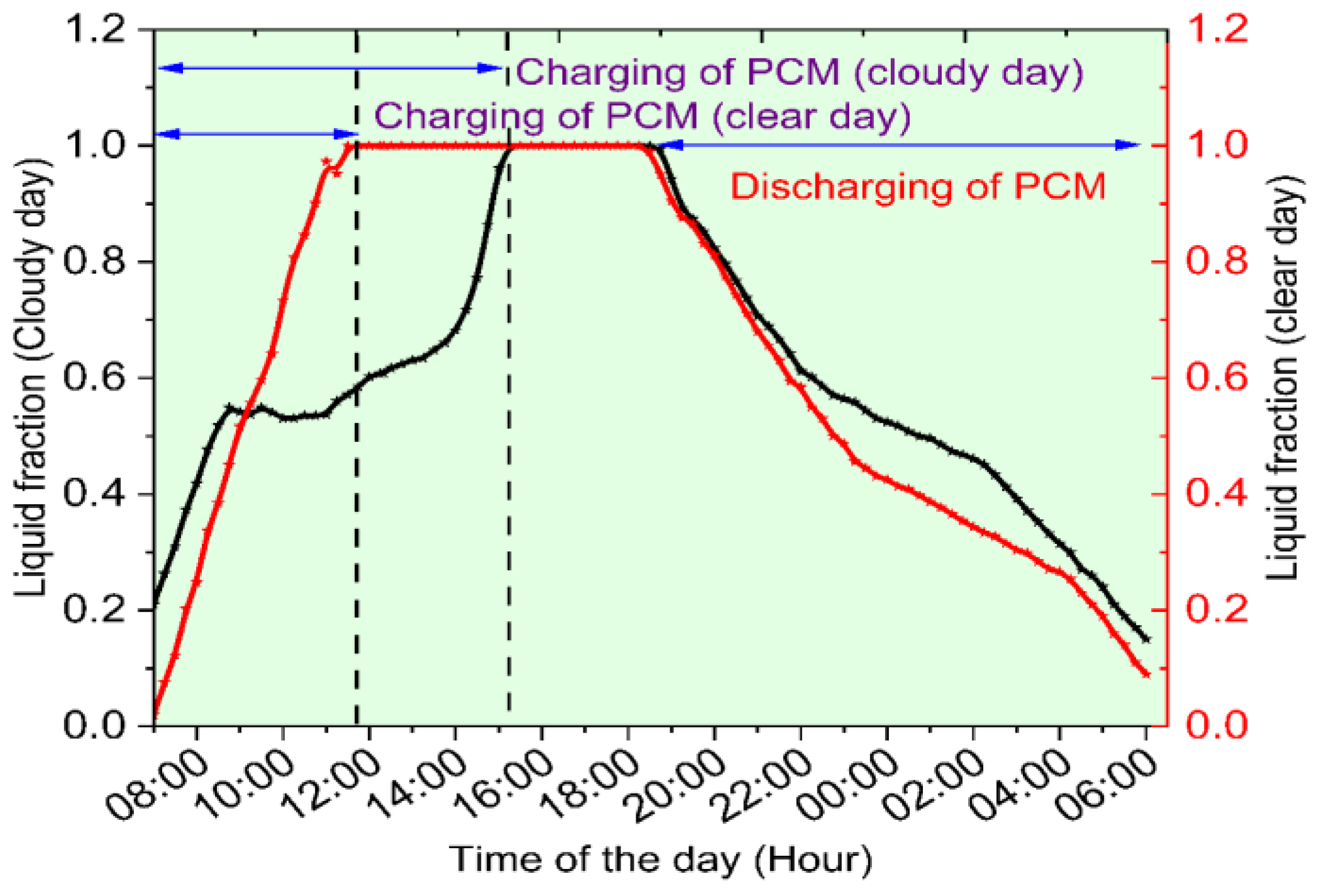
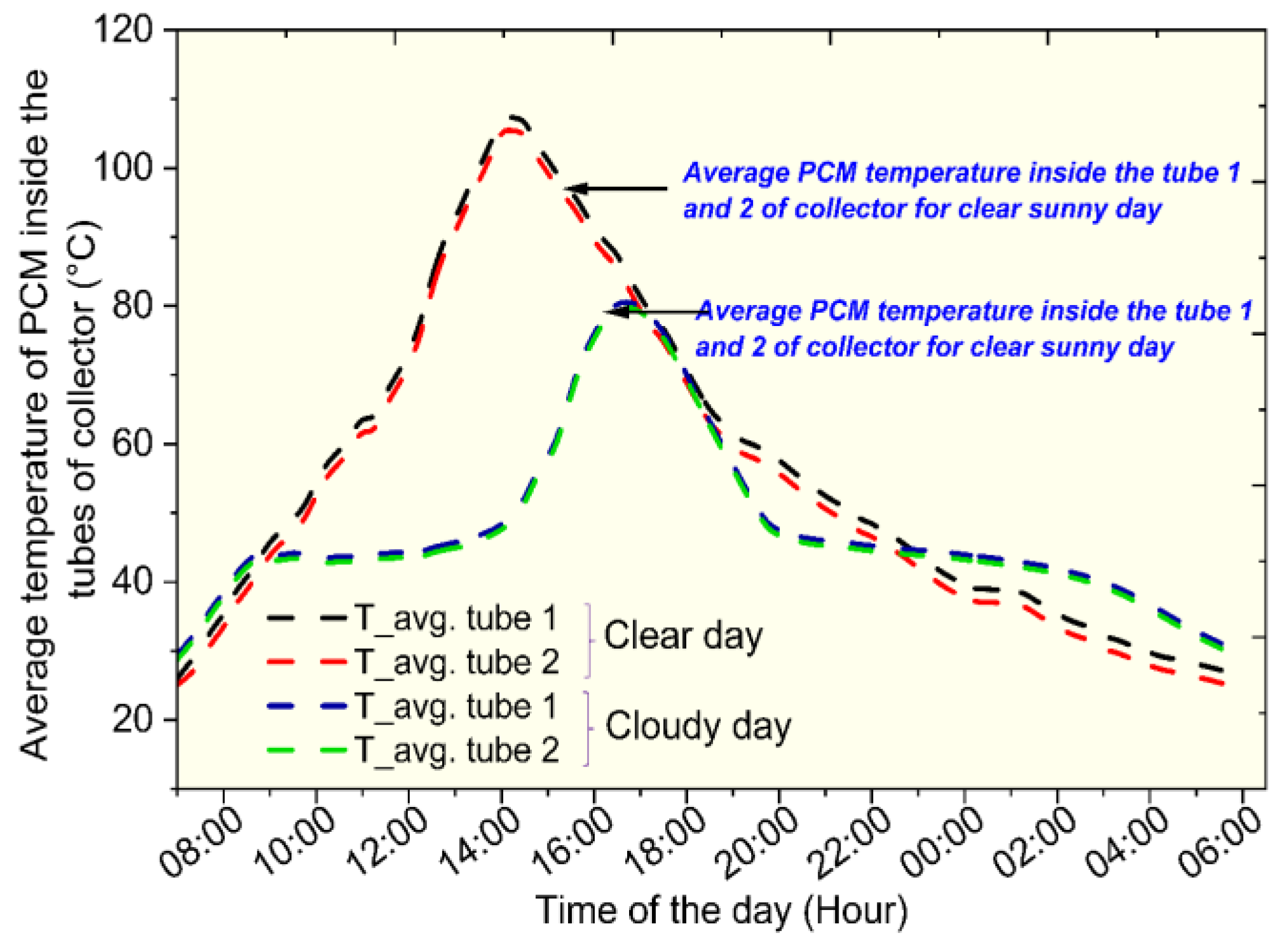

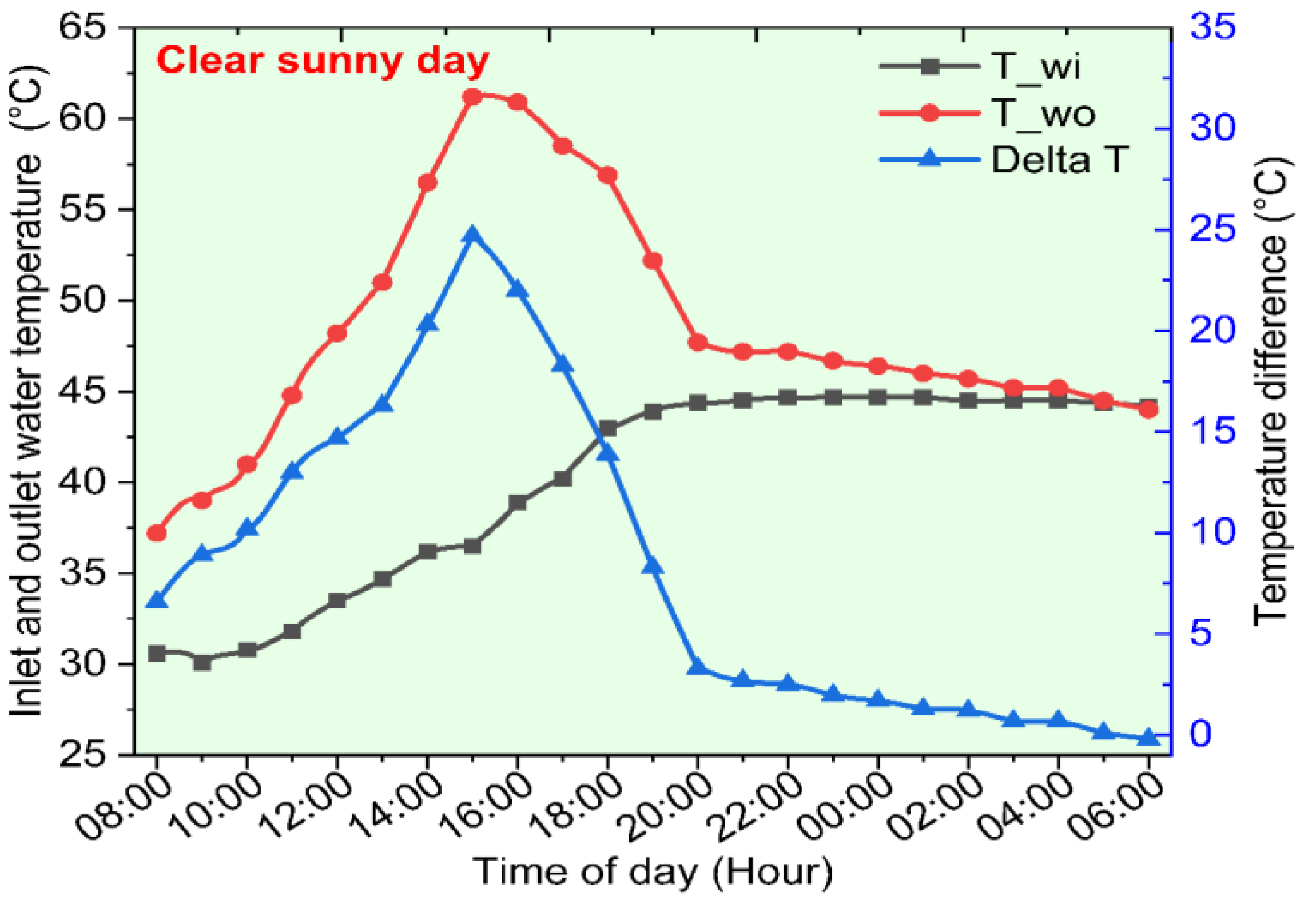
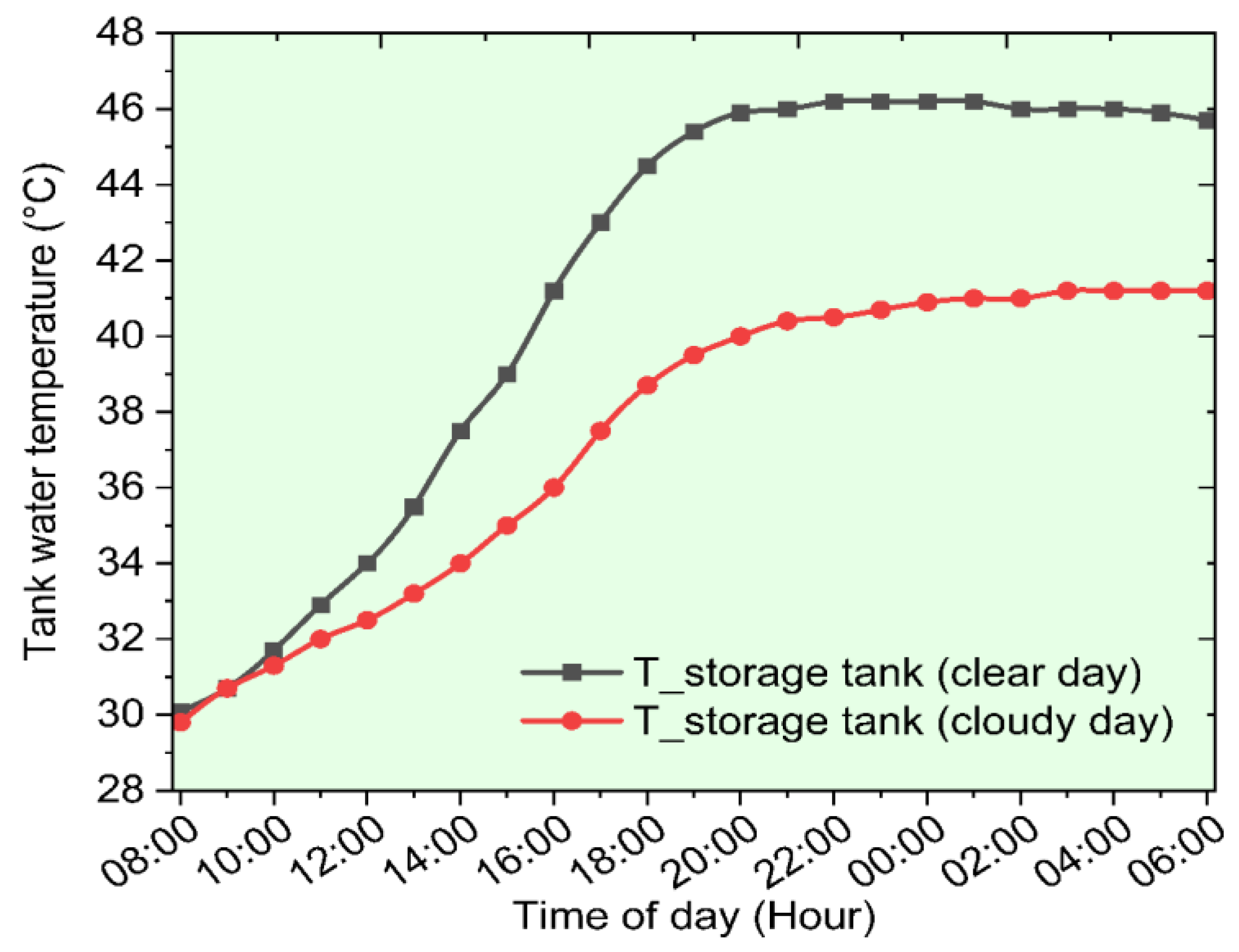

| S. No. | Property | Value in Range |
|---|---|---|
| 1 | Latent heat of fusion | 204.93–205.52 kJ/kg |
| 2 | Melting point (Tm) | 61.10–64.70 °C |
| 3 | Specific heat (Cps and Cpl) | 2.20–2.48 kJ/kg °C |
| 4 | Heat conductivity | 0.25 W/m K |
| 5 | Density of material (solid and liquid) | 0.85–0.89 g/cm3 |
| S. No. | Notation of Temperature | Temperature with Their Respective Position (°C) |
|---|---|---|
| 1 | T1 | Average temperature of PCM inside tube 1 |
| 2 | T2 | Average PCM temperature inside tube 2 |
| 3 | T3 | Temperature of the water at inlet |
| 4 | T4 | Temperature of the water at outlet |
| 5 | T5 | Stored water temperature |
| 6 | T6 | Ambient temperature |
| S. No. | Specifications | Value/Material |
|---|---|---|
| 1 | Evacuated tube length | 1800 mm |
| 2 | Glass material | Borosilicate glass |
| 3 | Thickness of glass | 2–3 mm |
| 4 | Absorptivity of absorber tube | >92% |
| 5 | Emissivity of absorber tube | <8% |
| 6 | Heat pipe material | Copper |
| 7 | Condenser section length | 63.5 mm |
| 8 | Evaporator section length | 1600 mm |
| 9 | Temperature range of RTDs | −50 °C to 550 °C |
| 10 | Submersible pump flow range | 0–2.6 LPM |
| 11 | Rotameter flow rate range | 0–1.6 LPM |
| Physical Parameters | Symbol | Value |
|---|---|---|
| Ambient temperature | Ta | 24 °C |
| Wind velocity | v | 0.8 m/s |
| Transmissibility | ꞇ | 0.85 |
| Absorptivity | α | 0.93 |
| Outer and inner tube emission coefficient | 0.9 | |
| Outer and inner tube reflection coefficient | 0.14 and 0.08 |
| Heat-Pipe-Based ETSC | Router tube-amb. (m2K/W) | Rinner to outer glass (m2K/W) | Rheat pipe-inner glass (m2K/W) | UL (W/m2 K) | ∑Rheat pipe (K/W) |
|---|---|---|---|---|---|
| Test 1 (clear day) | 0.056 | 1.68 | 3.7 × 10−4 | 0.75 | 3.91 |
| Test 2 (cloudy day) | 0.054 | 1.64 | 4.0 × 10−4 | 0.72 | 3.87 |
Disclaimer/Publisher’s Note: The statements, opinions and data contained in all publications are solely those of the individual author(s) and contributor(s) and not of MDPI and/or the editor(s). MDPI and/or the editor(s) disclaim responsibility for any injury to people or property resulting from any ideas, methods, instructions or products referred to in the content. |
© 2023 by the authors. Licensee MDPI, Basel, Switzerland. This article is an open access article distributed under the terms and conditions of the Creative Commons Attribution (CC BY) license (https://creativecommons.org/licenses/by/4.0/).
Share and Cite
Pathak, S.K.; Tyagi, V.V.; Chopra, K.; Pandey, A.K.; Sari, A.; Abdulateef, A.M. Energetic, Exergetic, and Heat Transfer Assessment of PCM-Integrated Heat-Pipe-Based ETSC for Clear and Cloudy Weather Conditions. Sustainability 2023, 15, 9780. https://doi.org/10.3390/su15129780
Pathak SK, Tyagi VV, Chopra K, Pandey AK, Sari A, Abdulateef AM. Energetic, Exergetic, and Heat Transfer Assessment of PCM-Integrated Heat-Pipe-Based ETSC for Clear and Cloudy Weather Conditions. Sustainability. 2023; 15(12):9780. https://doi.org/10.3390/su15129780
Chicago/Turabian StylePathak, Sudhir Kumar, V. V. Tyagi, K. Chopra, A. K. Pandey, Ahmet Sari, and Ammar M. Abdulateef. 2023. "Energetic, Exergetic, and Heat Transfer Assessment of PCM-Integrated Heat-Pipe-Based ETSC for Clear and Cloudy Weather Conditions" Sustainability 15, no. 12: 9780. https://doi.org/10.3390/su15129780
APA StylePathak, S. K., Tyagi, V. V., Chopra, K., Pandey, A. K., Sari, A., & Abdulateef, A. M. (2023). Energetic, Exergetic, and Heat Transfer Assessment of PCM-Integrated Heat-Pipe-Based ETSC for Clear and Cloudy Weather Conditions. Sustainability, 15(12), 9780. https://doi.org/10.3390/su15129780








